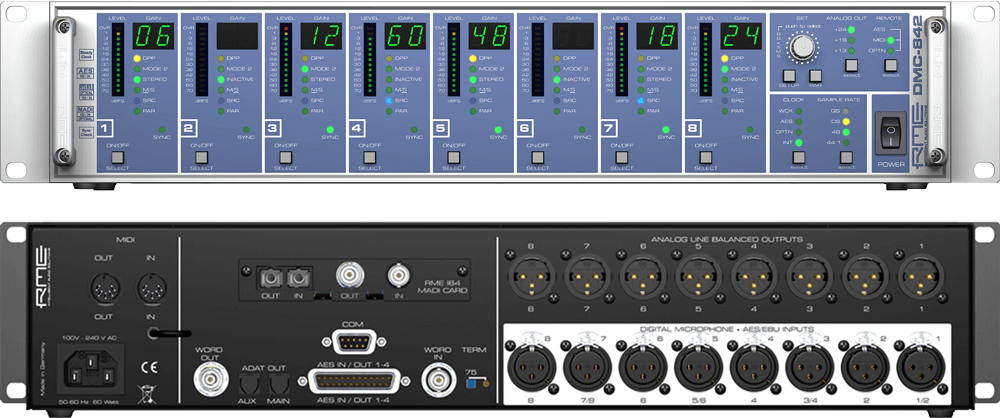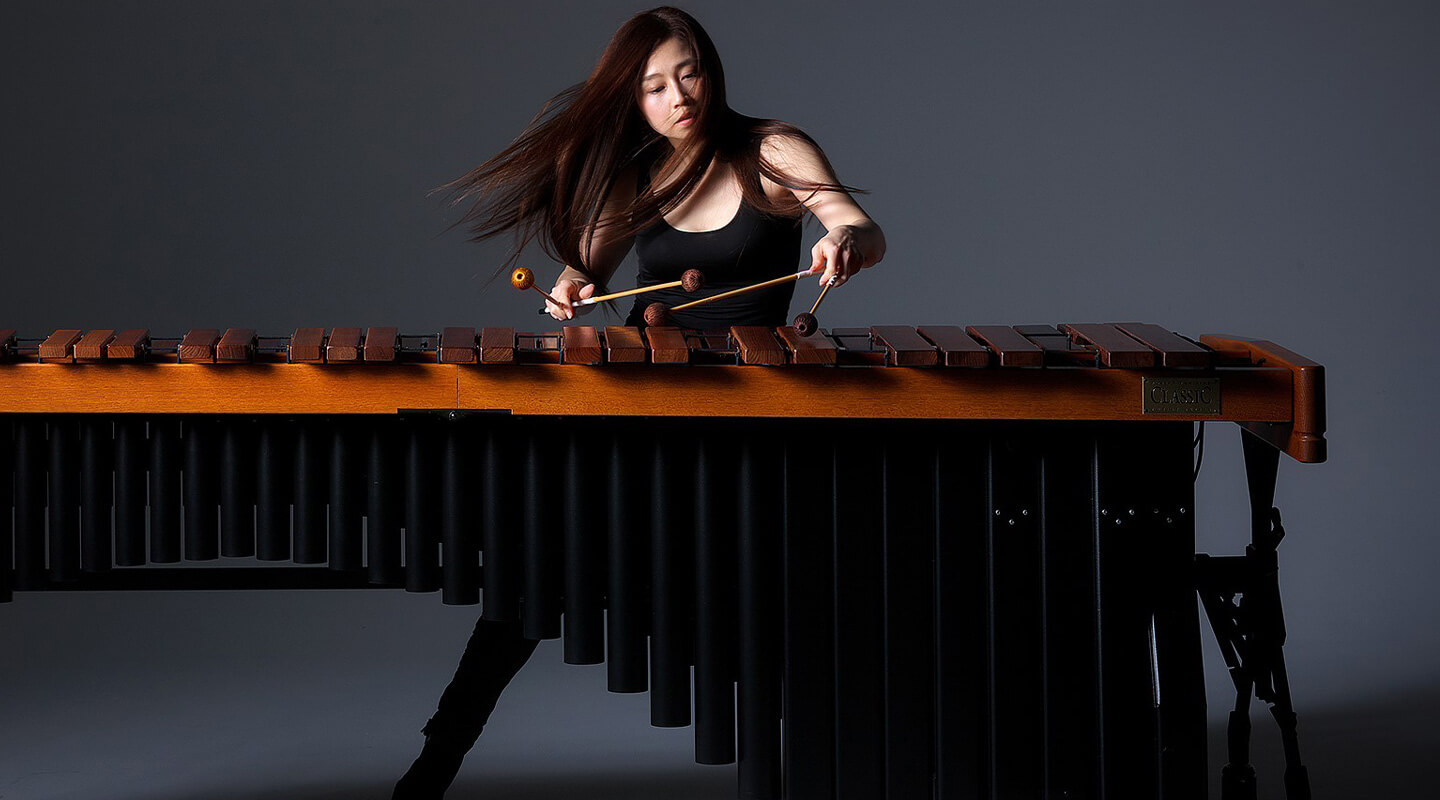DMC 842
8-Channel AES42 Interface for Digital Microphones


Connectivity and Features
When developing the DMC-842, RME worked closely with the microphone manufacturers to secure maximum compatibility and best functionality. As a result the DMC-842 is the most flexible and most compatible AES42 interface available - a true milestone for the broad acceptance of the new digital microphone technology.
The DMC-842 is fully remote controllable, via MIDI, AES and (optional) MADI. The optional I64 MADI Card provides serial pass-through capability from one DMC-842 to the next (up to 8). All up to 64 audio signals are then available at the last device on one single line. Such a way of cascading is also possible with the Micstasy and the ADI-8 QS. The signals passed through the DMC-842 are available at the analog outputs, making an expensive splitter box on stage obsolete.
Overview of the DMC-842's most important features:
- Fully compatible to AES42
- 8 XLR AES42 inputs (AES3 compatible)
- 8 balanced XLR Line outputs
- 24 bit sample rate conversion switchable per input
- Digital Phantom Power switchable per input
- Supports Mode 1 and Mode 2
- 63 dB gain range per channel, even in asynchronous Mode 1
- LED level meter with 13 LEDs per channel
- M/S de-/encoding
- 4 x AES/EBU Out via D-sub, 8 channels @ 192 kHz
- 2 x ADAT Out, 8 channels @ 96 kHz
- Optional MADI I/O (I64 MADI Card) with serial cascading and digital/analog return path
- MIDI I/O
- Fully remote controllable
- Future-proof by flash updates
Features
In a standard 19" box with 2 unit height the device offers numerous extraordinary features like Intelligent Clock Control (ICC) , SyncCheck ®, SteadyClock, MultiMode, MIDI over MADI, and remote control via MADI and MIDI.
The technologies known from other RME products like SyncCheck® ensure perfect synchronization and clear detection of errors. Also multiple units can be stacked and operated sample-aligned, using word clock. All settings are stored when the unit is switched off.
The DMC-842 can be fully remote controlled and configured via MIDI, and all status displays can be queried through MIDI. Each DMC-842 can be given a separate ID, allowing separate remote controllability of various devices with only one MIDI channel.
RME's SteadyClock(TM) guarantees excellent clock quality in any situation. Due to the highly efficient jitter reduction, the DMC-842's DA-converters operate independently from the quality of the external clock signal, as if they are working with internal clock all the time - guaranteeing a pristine sound quality! Additionally Intelligent Clock Control (ICC) will retain the last valid sample frequency in case of a loss of the input signal.
AES42
The DMC-842 operates as power supply and control device for digital microphones, supporting the AES42 standard. The operating modes defined in AES42, Mode 1 and Mode2, are supported individually per input. Mode 1 defines an asynchronous operation. Working with several Mode 1 microphones requires the use of sample rate converters, which are included in the DMC-842. Mode 2 allows for a synchronized operation. In both modes control data can be sent to and status data can be received from the microphone. These can settings for gain, polar patterns, hi-pass filter and compression. Further functions are already specified in the AES42 standard, but availability depends on the individual microphone. All microphone parameters are directly accessible from the unit's front panel.
As Digital Phantom Power can be switched on or off on individual channels, the DMC-842 can also handle 'standard' AES3 and AES/EBU signals at the same time. Using the built-in sample rate converters, these can even be asynchronous.
In many respects, the DMC-842 is an ideal companion to RME's Micstasy. Using the same interface connections as found in the Micstasy (ADAT S/MUX and AES/EBU built-in, MADI optional) it ensures problem-free set-up of combined systems for both analog and digital microphones. The DMC-842 even includes analog line level outputs, so a mixed setup with purely analog devices (for example for monitoring purposes) poses no problems.
Remote Software
The included Windows software DMC-Control can use any existing MIDI port within the system to perform remote control and status requests of any number of DMC-842s via a simple mouse click. The latest version of the program can be downloaded for free from the RME website. The program is self-explanatory and very easy to use. It manages up to 8 DMC-842 simultaneously. Names can be assigned to all channels and all devices. DMC-Control not only offers a remote-access to all front panel settings, but also a comfortable configuration of the Setup menu, and direct access to the AES42 features of the connected microphones.
Accessories
Optional: MADI I/O (I 64 MADI Card)
The I64 MADI Card provides the DMC-842 with a 64-Channel MADI input and output. Coaxial and optical output operate in parallel to the AES/EBU and ADAT output, therefore deliver the same data.
The I64 MADI Card features an optical as well as a coaxial MADI input. The input is switched automatically, according to where a valid input signal is detected. Full redundancy is ensured by the automatic input switching, immediately changing to the other input in case of loss of the input signal.
The MADI input will operate as an optional clock source (Clock section, OPTN) as well as a thru-input. Since each DMC-842 uses only 8 channels, up to 56 channels can be passed through. This technique is used to serially cascade several DMC-842. Incoming MADI data is passed through unchanged, only one block of eight channels is replaced. This allows up to 8 devices to be connected serially. All 64 combined channels are available at the last device's MADI output.
With an installed I64 MADI Card the DMC-842 can be remote controlled via MADI. At the same time MIDI data are transmitted via MADI.
Using the I64 MADI Card provides the ability of 8 channels being used as return path, sending audio via MADI to the DMC-842's ADAT, AES and analog outputs. For example stage and studio monitors can be fed from the DMC-842. The MADI output continues to carry the analog input signals and the fed-through input data.
Specs
DMC-842
- Inputs: 8 x XLR (AES42, AES3 compatible), 1 x D-sub (AES sync)
- Outputs digital: 4 x AES/EBU via 25-pin D-sub, 2 x ADAT optical, optional MADI
- Outputs analog: 8 x XLR, balanced, up to +24 dBu
- Signal to Noise ratio DA (SNR): 116 dB RMS unweighted, 119 dB(A)
- THD DA: < -104 dB (< 0.00063%)
- THD+N DA: < -100 dB (< 0.001%)
- Crosstalk DA: < 110 dB
- Output level @ 0 dBFS: +24 dBu, +19 dBu, +13 dBu
- Frequency response DA, -0.5 dB: 5 Hz - 22 kHz (sf 48 kHz)
- Frequency response DA, -0.5 dB: < 5 Hz - 34 kHz (sf 96 kHz)
- Frequency response DA, -1 dB: < 5 Hz - 50 kHz (sf 192 kHz)
- Sync sources: Internal, AES, word, Option (MADI)
- Sample frequencies: 44.1 kHz, 48 kHz, 88.2 kHz, 96 kHz, 176.4 kHz, 192 kHz, variable (external clocks)
- Sample rate range: MADI: 32 - 192 kHz, word clock: 27 kHz - 200 kHz, AES: 28 kHz - 200 kHz
- Jitter: Typical < 1 ns for internal, word clock, AES and MADI input
- Jitter suppression: >30 dB (2.4 kHz)
- Jitter sensitivity: all PLLs operate error-free even at 100 ns
- Power supply: Internal switching mode PS, 100V - 240V AC, 60 Watt
- Dimensions: (WxHxD) 483 x 88 x 200 mm
- Warranty: 2 years
All specifications are subject to change without notice.
Drivers
DMC-842
MIDI Remote Control Software for DMC-842

